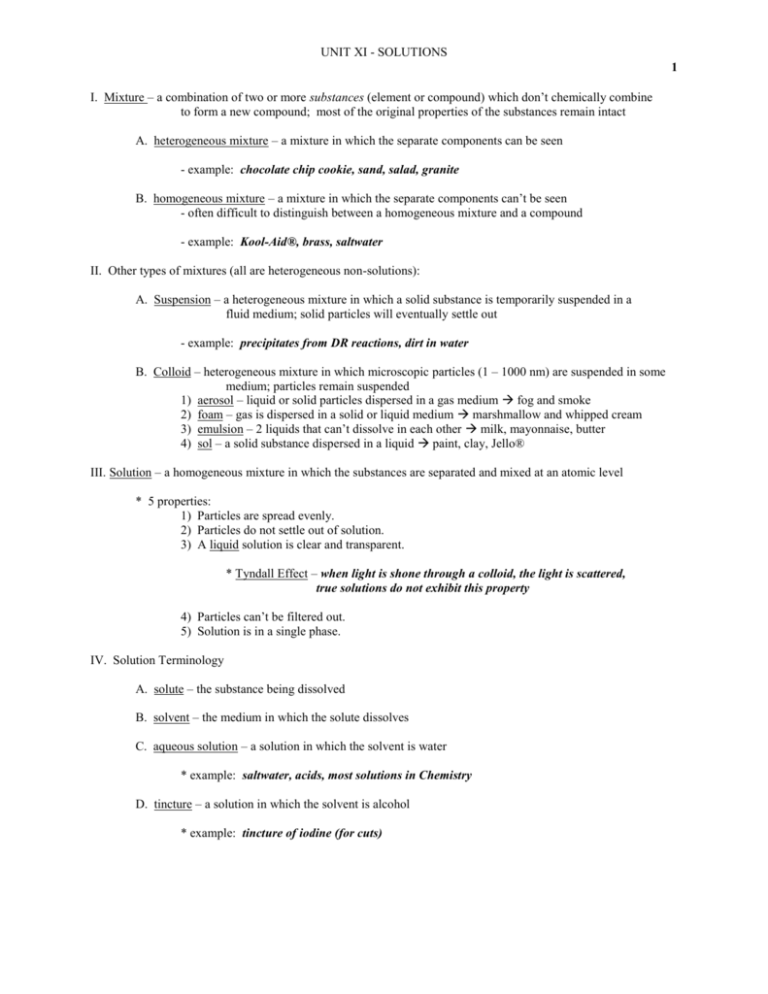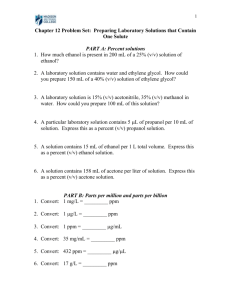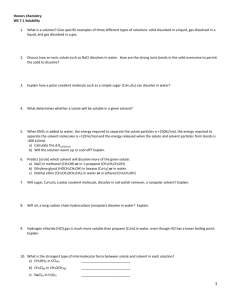Solutions Notes - Holland Public Schools
advertisement

UNIT XI - SOLUTIONS 1 I. Mixture – a combination of two or more substances (element or compound) which don’t chemically combine to form a new compound; most of the original properties of the substances remain intact A. heterogeneous mixture – a mixture in which the separate components can be seen - example: chocolate chip cookie, sand, salad, granite B. homogeneous mixture – a mixture in which the separate components can’t be seen - often difficult to distinguish between a homogeneous mixture and a compound - example: Kool-Aid®, brass, saltwater II. Other types of mixtures (all are heterogeneous non-solutions): A. Suspension – a heterogeneous mixture in which a solid substance is temporarily suspended in a fluid medium; solid particles will eventually settle out - example: precipitates from DR reactions, dirt in water B. Colloid – heterogeneous mixture in which microscopic particles (1 – 1000 nm) are suspended in some medium; particles remain suspended 1) aerosol – liquid or solid particles dispersed in a gas medium fog and smoke 2) foam – gas is dispersed in a solid or liquid medium marshmallow and whipped cream 3) emulsion – 2 liquids that can’t dissolve in each other milk, mayonnaise, butter 4) sol – a solid substance dispersed in a liquid paint, clay, Jello® III. Solution – a homogeneous mixture in which the substances are separated and mixed at an atomic level * 5 properties: 1) Particles are spread evenly. 2) Particles do not settle out of solution. 3) A liquid solution is clear and transparent. * Tyndall Effect – when light is shone through a colloid, the light is scattered, true solutions do not exhibit this property 4) Particles can’t be filtered out. 5) Solution is in a single phase. IV. Solution Terminology A. solute – the substance being dissolved B. solvent – the medium in which the solute dissolves C. aqueous solution – a solution in which the solvent is water * example: saltwater, acids, most solutions in Chemistry D. tincture – a solution in which the solvent is alcohol * example: tincture of iodine (for cuts) UNIT XI - SOLUTIONS 2 V. Types of solutions A. Gas Solutions - air B. Liquid Solutions 1. solid in liquid – saltwater, Kool-Aid® 2. liquid in liquid – antifreeze, gasoline 3. gas in liquid – HCl, soda (CO2 in water), ammonia (NH3 in water) C. Solid Solutions * alloy – a solution which contains 2 or more metals; the metals don’t chemically combine to form a new compound; produced by melting the metals, mixing them together, then allowing them to cool - example: brass (Cu & Zn), bronze (Cu & Ni), steel (Fe, C, Ni, Cr) VI. Antifreeze A) colligative properties - properties that a solution shows which are different than the properties of the pure solvent - examples: boiling point elevation, freezing point depression B) How does antifreeze work? C = 212oC o o Freezing point of pure water = 0 C = 32 F 1) Boiling point of pure water = 100 o 2) 3) Adding ethylene glycol to water causes the boiling point to increase and the freezing point to decrease. 4) As a result, the solution will remain a liquid at a larger range of temperatures. 5) Disadvantage specific heat of water = 4.18 J/g-oC specific heat of ethylene glycol = 2.39 J/g-oC VII. Kinetic Theory of Solution * “piranha and cow” theory: * solvent particles are attracted to solute particles by dipole-dipole forces (or some other similar force). The solvent particle then separates the solute particles from the other surrounding solute particles. Once the separation is complete, other solvent particles attach to the solitary solute particle. This process continues until all the solute particles are separated or the solvent runs out (saturated solution). UNIT XI - SOLUTIONS 3 VIII. Rate of Solution - speed at which solute dissolves; think how it relates to piranha/cow theory * 4 factors that affect rate of solution: 1. size of particles – smaller particles have more surface area exposed, therefore more solvent particles can bond with solvent at a time 2. stirring – moves “fresh” solvent molecules in contact with solute more quickly 3. amount of solute already dissolved – if solvent molecules are already hydrated less are available for bonding with solute 4. temperature – as temperature increases, solvent particles are moving more quickly, so they bond and separate more quickly IX. Solubility - amount of solute which dissolves in a solvent at a given temperature * 3 factors that affect solubility: 1. Nature of solute and solvent * “like dissolves like” – polar substances dissolve in other polar substances; nonpolar dissolves in nonpolar; polar and nonpolar do not mix 2. Temperature a. solid and liquid solutes – generally, as temperature increases, solubility increases (see graph on p. 4) b. gas solutes – as temperature increases, solubility decreases (see p. 4) * thermal pollution - why is this a problem?? – adding hot water to a lake or river (hot water is often a waste product of power plants) causes the solubility of oxygen (O2) to decrease, causing much of it to escape into the atmosphere. As a result, there is less O2 available for fish to breathe. 3. Pressure - gas solutes only; sodapop * Henry’s Law – as pressure increases, solubility of gases increase X. Saturation A. saturated solution – a solution which is holding as much solute as it is able at that temperature B. unsaturated solution – a solution which is able to hold more solute at that temperature C. supersaturated solution – a solution which is holding more solute than it is able at that temperature * How is this possible? * make a saturated solution in hot water, and let it cool. As the temperature decreases, the solubility decreases. If crystals are unable to form, the solution is supersauturated. UNIT XI - SOLUTIONS 4 XI. Solubility Curve - shows maximum amount of solute that can dissolve in water at given temperatures * note: for most, as temperature increases, solubility increases - exceptions? SO2, NH3, HCl all are gases (see p. 3 XII 2)B. ) S. 1) How many grams of ammonia can dissolve in 100g of water at 10oC? 2) Which of the following: 72g 50oC? 3θg NH3, KClO3, KCl, NaCl would be least soluble at 70oC? NH3 40oC? KClO3 - Which is the most soluble at 100oC? KClO3 3) If you added 7θg of NH4Cl to 10θg of water at 50oC, is the solution saturated, unsaturated, or supersaturated? Saturated (note from graph: only 51 g of NH4Cl is able to dissolve at that temperature) - How much is left over? 7θg – 51g = 19g left over 4) How many grams of KNO3 can dissolve in 20θg of water at 50oC? 87 gKNO3 x 100 gH 2O 200 gH 2O x = 174g KNO3 UNIT XI - SOLUTIONS 5 XII. Molarity - a mathematical way to express concentrations of solutions Molarity moles solute liters solution T. 1) What is the molarity of a 2.00 liter solution which contains 5.00 liters of HCl gas dissolved in it? Assume the conditions are STP 5.00 LHCl M 1moleHCl 0.223molHCl 22.4 LHCl 0.223 mol 0.112M 2.00 L 2) How many liters of a 0.100 M Pb(NO3)2 solution do you need to get 0.0285 moles of lead nitrate for your reaction? 0.100 M 0.0285 mol 0.0285 mol 0.285L 0.100M V 0.0285mol V 0.100M V 3) How many grams of NaCl are needed to make 5.00 L of a 0.100 M NaCl solution? 0.100 M x 5.00L x (0.100M )(5.00 L) 0.500molNaCl 58.5 gNaCl 29.3gNaCl 1molNaCl *4) What is the molarity of a saturated KNO3 solution at 40oC? * SEE GRAPH ON p. 4: 66 gKNO3 1moleKNO3 0.653molKNO3 101gKNO3 66 gKNO3 0.653molKNO3 6.53M 100 gH 2O 0.100 L * 100g H2O = 100 mL H2O (Density is 1 g/mL) = 0.100 L H2O S. 1) What is the molarity of a solution in which 40.0g NaCl is dissolved into a 0.500 L solution? 40.0 gNaCl M 1moleHCl 0.684 gNaCl 58.5 gNaCl 0.684 mol 1.37 M 0.500 L 2) How many liters of a 2.00 M NaOH solution are needed for a reaction that requires 3.55g of NaOH? 3.55 gNaOH 1moleNaOH 0.08875molNaOH 40.0 gNaOH V 0.08875 mol 0.0444 L 2.00M 3) How many grams of iron(III) chloride (FeCl 3) are needed to make 20 mL of a 0.100 M iron(III) chloride solution? 0.100 M x 0.200L x 0.0200molFeCl3 162 gFeCl3 3.24 gFeCl3 1molFeCl3 4) What is the molarity of a saturated KClO3 solution at 80oC? 42 gKClO3 1moleKClO3 0.343molKClO3 123 gKClO3 42 gKClO3 0.343molKClO3 3.43M 100 gH 2 O 0.100 L * 100g H2O = 100 mL H2O (Density is 1 g/mL) = 0.100 L H2O UNIT XI - SOLUTIONS 6 XIII. Parts per Million (ppm) ppm grams solute mg x1,000,000 in aqueous sol' n grams solvent L T. 1) What is the concentration of a solution (in ppm) in which you dissolve 1.00g of sugar molecules in 50.0 mL of water? ppm 1.00g sugar x1,000,000 20, 00 ppm 50.0g water 2) What is the concentration of a solution (in ppm) in which you dissolve 1.00mg of lead(II) nitrate in 15 mL of water? 1.00 x10 3 g 1.00mg x1mil 6.67 ppm OR 6.67 ppm 0.150 L 15g 3) The sodium ion concentration listed on a 1.00 L bottle of NAYA is 4 ppm. What is the molarity of salt here? Assume salt is sodium chloride, and 1.00 L water = Volume solution 4ppm M x mg sodium 1mol NaCl x 4mg 0.040 g NaCl 6.8 x10 4 mol NaCl 1.00L water 58.5 g NaCl 6.8 x10 4 mol NaCl 6.8 x10 4 M 1.00 L S. 1) What is the concentration of a solution (in ppm) in which you dissolve 2.50g of calcium chloride (CaCl2) in 50θ mL of water? ppm 2.50g 5.00 ppm 0.500L 2) What is the concentration of a solution (in ppm) in which you dissolve 20θmg of urea in 50 cm3 of water? Urea: (NH2)2CO ppm 0.200 g 0.400 ppm 40ppb 0.500 L 3) The bicarbonate concentration listed on a 1.00 L bottle of NAYA is 13ppm. What is the molarity? 12ppm 1mol NaHCO 3 x mg bicarb x 12mg 0.120 g NaHCO 3 1.43x10 3 mol NaHCO 3 1.00L water 84 g NaHCO 3 1.43x10 3 mol NaHCO 3 M 1.43x10 3 M 1.00 L UNIT XI - SOLUTIONS 7 XIV. Percent By Mass % by mass g solute x100 g solution T. 1) If 18.0g of sodium sulfate are dissolved in 205.0g of water, what is the % by mass of this solution? 18.0g sodium sulfate + 205g water = 223 g solution % by mass 18.0g sodium sulfate x100 8.07% 223g solution 2) What is the mass of NaCl needed to make 75 mL of a 5.00% NaCl solution? (assume density = 1 g/mL) 5.00% x x100 x = 37.5g NaCl 75g solution 3) How many grams of water are needed to make a 3.00% solution if you have 150.0 g of NaCl? 3.00% 150.0g NaCl x100 x x = 5000g solution – 150g NaCl = 4850g water S. 1) What is the percent by mass of a solution in which 25.0g of H2SO4 is dissolved in 75.0g of water? 25.0g sulfuric acid + 75g water = 100 g solution % by mass 25.0g H 2 SO4 x100 25.0% 10g solution 2) How many grams of KBr are needed to make 25 mL of a 2.00% solution? 2.00% x x100 x = 5.00g KBr 25g solution 3) How many grams of water are needed to make a 6.34% solution with 1.50g of K2CrO4? 6.34% 1.50g K 2CrO4 x100 x = 23.7g solution – 1.5g K2CrO4 = 22.2g water x UNIT XI - SOLUTIONS 8 XV. Dilution Problems * dilution - the process of making a solution less concentrated by adding more solvent MiVi = MfVf T. 1) To what volume must you dilute 10 mL of a 2.00 M HCl solution to get a 0.500 M HCl solution? (2.00M)(10θmL) = (0.500M)V2 Vf = 40θ mL 2) If you add 25 mL of water to 10 mL of a 6.00 M NH3 solution, what is the molarity of the diluted solution? 250mL water + 100 mL concentrate = 350 mL final volume (6.00M)(10θmL) = Mf(35θmL) Mf = 1.71M 3) How many cm3 of water must be added to 50.0 mL of a 0.100 M AgNO3 solution to dilute it to 0.0750 M? (0.100M)(50.0mL) = (0.0750M)Vf Vf = 66.7 mL solution 66.7 mL solution - 50.0 mL concentrate = 16.7 mL water added S. 1) What volume of 2.00 M H2SO4 is needed to make 1.00L of a 0.500M H2SO4 solution? (0.500M)(1.00L) = (2.00M)Vf Vf = 0.250L 2) If you add 0.500L of water to 1.50L of a 3.50 M NaCl solution, what is the molarity of the diluted solution? (3.50M)(1.50L) = Mf(2.00L) Mf = 2.63 M 3) What volume of water is needed to dilute 25.0 mL of a 2.44 M sugar solution to 1.00 M? (2.44M)(25.0mL) = (1.00M)Vf Vf = 61.0 mL solution 61.0 mL solution – 25.0 mL concentrate = 36.0 mL water added







